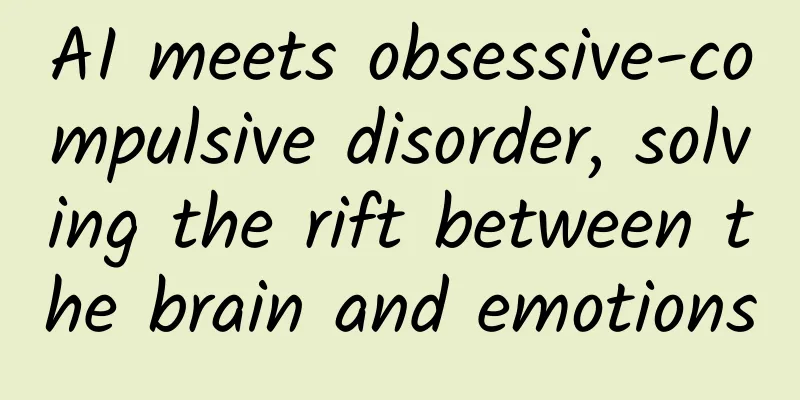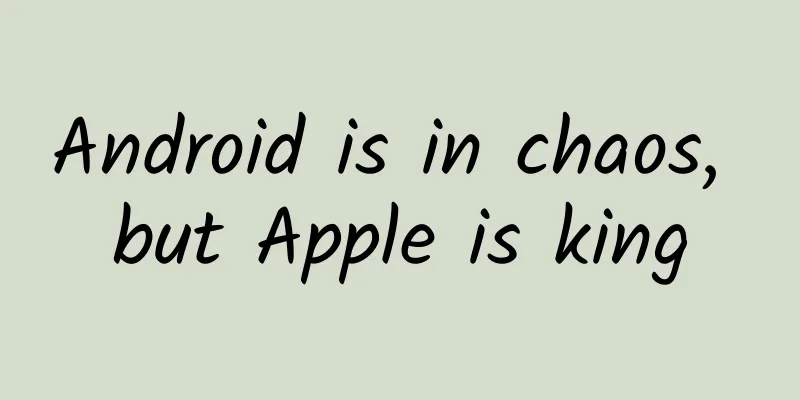AI meets obsessive-compulsive disorder, solving the rift between the brain and emotions

|
As the New Year is coming to an end, many people have already started planning and organizing their schedules. Whether it is buying New Year's gifts or deep cleaning the house, everything has been put on the agenda. For those who are laid back, it is OK to ask a nanny to come and clean three days in advance. If there is no possibility of a party at home, some people may not do anything and keep it as it is. People who are used to planning will start to take out notebooks and various disks. More extreme obsessive-compulsive "patients" may have already calculated exactly what they should do every day. If there is such an obsessive-compulsive patient around you, you may have a deep understanding of this situation. We often joke about people with obsessive compulsive disorder, but in fact, some people are perfectionists and like to be serious. But among them, there are also people whose lives and work may be deeply affected by obsessive compulsive disorder. Such people will have a psychological burden on their obsessive compulsive behavior, want to get rid of it but have no choice, and cannot control their behavior and thoughts, and anxiety is always around. We may have known that the common treatments for severe obsessive-compulsive disorder are psychological intervention and drug therapy. Psychological intervention and drug therapy are common methods, but for some patients with obsessive-compulsive disorder, these treatments have no effect. This group of people began to look at deep brain stimulation as a treatment. Deep brain stimulation can have a very good therapeutic effect. More than half of the patients with obsessive-compulsive disorder have significantly improved symptoms and significantly improved their quality of life. However, the symptomatic treatment effect for some patients with obsessive-compulsive disorder is not ideal, but their accompanying symptoms such as anxiety and depression have been significantly improved. Deep brain stimulation has a good feedback effect on the treatment of some mental illnesses, but during the treatment process, the frequency and intensity of deep brain stimulation are related to the doctor's experience, which also means that this type of treatment method has high requirements for the doctor's level and experience, and has a large room for improvement. Recently, a research analysis using AI identified the brain wave signals related to obsessive-compulsive disorder in the brain for the first time, bringing new benefits to the diagnosis and targeted treatment of obsessive-compulsive disorder. AI captures EEG signals of obsessive-compulsive disorder For patients with obsessive-compulsive disorder, the frequency and intensity of deep brain stimulation are linked to the doctor's level of experience. The treatment and management of the disease are unstructured and relatively complex. Accurately stimulating deep brain electrical activity areas and identifying the onset of obsessive-compulsive disorder in patients become key links in machine intervention. Using AI technology to identify OCD-related brain wave signals in the brain and adjusting the intensity of deep brain stimulation based on this signal has opened a new window for targeted and precise treatment of OCD. This research team is from the Institute of Brain Science at Brown University in the United States. The research team led by Professor David A. Borton conducted long-term EEG monitoring on 5 patients with severe obsessive-compulsive disorder. After long-term collection, research and observation, they used artificial intelligence to analyze the compulsive behaviors in the patients' lives, evaluate the patients' various subtle emotional changes, and match them with brain wave activities. In addition to brain wave signals, the researchers also collected a set of biomarkers of obsessive-compulsive disorder patients' behaviors, including facial expressions and body movements. Through artificial intelligence, they found that these behaviors and characteristics are closely related to changes in internal brain signals. In addition, the researchers have also proved through experiments that when patients have these obsessive-compulsive symptoms, the deep brain stimulation location given by AI can significantly improve the patient's obsessive-compulsive symptoms. The researchers are also constantly improving the deep brain stimulation system and moving towards automated stimulation. What does this mean? When patients show signs of obsessive-compulsive disorder, the system can automatically capture and promptly use deep brain stimulation for targeted relief, automatically adjusting the intensity of stimulation according to the intensity of the patient's symptoms. Currently, researchers plan to further recruit more patients for trials to capture more obsessive-compulsive disorder EEG signal markers and enrich the functions of the automated deep brain stimulation system. Researchers are currently developing an automated deep brain stimulation system. In the field of life sciences, we see AI technology increasingly integrated into all stages of disease diagnosis and treatment. In some areas with limited manpower, technology can amplify the depth and breadth of exploration, opening up more room for growth for health and life. In the delicate field of mental health, AI is also extending its tentacles further. Warning and Elegy of Life We know that in today's high-pressure life, from students to adults, there is a large proportion of mental health imbalance. According to the data of the National Health Commission in 2019, the prevalence of depression in my country reached 2.1%, the prevalence of anxiety disorders was 4.98%, and the prevalence of depression and anxiety disorders reached 7%. Judging from the mental health of people around us, the real data should be more serious than the data ratio of the study. Mental health diseases, especially the high prevalence and suicide rates of depression, can have serious negative impacts on individuals and families. Therefore, it is very necessary to identify signs of depressive tendencies early and provide professional help. Huang Zhisheng, a professor at the Department of Artificial Intelligence at the Free University of Amsterdam, the Netherlands, launched the "Tree Hole Project" to investigate the tendencies exposed in social networks and the subsequent interventions. The "Tree Hole Robot" will monitor the information data in a specific social network every day, summarize and intelligently analyze the data information on the social network, and judge the possibility and risk of suicide. It will pay special attention to people with suicidal plans or behaviors every day, and generate reports for daily notifications. This type of intervention method uses knowledge graph technology as background support, which can realize logical reasoning and logical judgment, conduct 24-hour monitoring, automatically calculate suicide risks, and then issue monitoring reports in real time. It has positive significance for focusing on and intervening in key groups. Professional psychological counselors can save lives at critical moments. Of course, in addition to the more obvious semantic depression tendency in social networks, there are also changes in facial expression characteristics to distinguish whether there is a tendency to depression. Research analysis shows that the accuracy of this type of facial detection is 78%. In terms of tone, the speech speed of patients with depression will also have some obvious characteristics, such as slower speed, longer pause intervals, flat tone, and more obvious breath. The use of AI-assisted diagnostic tools that can identify patients with depression can improve doctors' work efficiency and detect depression early, providing the possibility for active intervention. However, there are also some controversial voices in the process of AI technology in the diagnosis and treatment of mental illness. Cold AI and hot emotions: Will patients buy it? We know that AI technology has powerful image recognition, information processing and analysis capabilities. It can play a role beyond human capabilities in the diagnosis and treatment of mental illness. However, for patients, using cold machines to treat mental illness will also cause various psychological feelings, and there are various answers to whether they can fully accept machine intervention in their psychology. Much of what we see about AI's benefits in mental health comes from the perspective of doctors and institutions. For patients, the actual effects and feelings are in a gray area and are often treated vaguely. No matter how much a machine resembles a human being, and how well it can imitate the words and emotions of a psychotherapist, it is still a machine after all. For patients who need empathy and emotional support, if they don’t know that the “psychologist” behind them is a machine, they can still accept it; if they know that it is a machine, they will have some doubts and embarrassment. Some patients have expressed this skepticism, believing that AI lacking emotion is too far from being able to treat emotional mental illnesses. Moreover, AI machines are unable to learn or empathize with human emotions, which makes patients somewhat resistant and unconvincing. Of course, AI treatment of mental illness will have some indescribable and reconciled difficulties at the patient's cognitive level. At the ethical level, the application of AI also has potential risks that make it difficult for the public to accept. For example, the ethics of storing and sharing mental health data, as well as the autonomy and privacy level of its learning system, etc. All these make AI's upgrade and evolution in the field of mental health hindered. Mental health is a relatively special type of human disease. Many people feel ashamed of this type of disease due to the pressure of the social environment. When patients open their hearts and muster up the courage to go to hospitals and professional institutions for diagnosis and treatment, they are faced with machines, which can be an unsettling factor that causes psychological fluctuations for patients. Discussions on AI in the field of mental health still need to be cautious and segmented. If it is a treatment area like deep brain stimulation, the intervention of machines will not cause any psychological barriers for patients, because it is AI that complements the technical level of doctors. However, for in-depth discussions and analysis, the use of AI technology to intervene requires segmentation in the process. If the intervention of AI technology is clearly needed, transparent diagnosis and treatment will make patients more psychologically accepting. The application of AI technology in the field of mental health has promoted the accurate identification and treatment of mental health diseases. However, it cannot completely replace professional doctors and psychological counselors. From the patient's perspective, it can be regarded as a tool to assist doctors in diagnosis, support and intervention. For some concerns about the process or even psychological obstacles and fluctuations, you should actively communicate with the doctor if necessary. If you add more burdens during the treatment process, it will not be worth it. Regardless of the stage of diagnosis and treatment, AI technology is actively involved and effective. Of course, the positioning of technology is always auxiliary. In the field of mental health, as the subject and recipient of the application, the perception of the efficacy of both parties is the most important. The improvement of emotions and cognitive thinking is the standard of measurement, and it is always the only standard. |
<<: Laxatives are poisonous. How can I poop comfortably?
>>: Ding Dong! Your express has arrived. How can I receive it safely?
Recommend
How to build a successful brand? Share 4 tips!
All brand models are based on psychological princ...
Cars.com: Tesla Model Y tops 2022 American Made Index
The American automotive website Cars.com recently...
What is the relationship between the "different world" of karst caves and groundwater?
recently In Nalangtun, Bamu Township, Tian'e ...
Why is Samsung in such a hurry to compete with Apple, Google, Dell, etc.?
[[143070]] Today, this saying should also be rega...
The most complete salon event planning summary in history!
Introduction: For operations personnel, the work ...
Why did the 4G version of Redmi Note abandon MediaTek?
The day before yesterday, Xiaomi officially relea...
This is the Nth pain point of iOS: I couldn’t agree more
Apple will hold its annual Worldwide Developers C...
91 Ten Articles: China's car exports to Australia soared, Skyworth said it would invest another 30 billion to build cars
1. Changan Automobile plans to increase its layou...
Are marketing and operations unclear? Let's take a look at their essential differences and 5 major inspirations
The ambiguous relationship between marketing and ...
Deloitte: Is GenAI a game-changer in medical technology?
Across industries, the discussion around artifici...
Uber is facing a series of crises, and many employees have lost confidence and are looking for new ways out.
According to the online version of the Financial ...
Fans are productivity. The Internet subverts the rules of the game for Chinese films
For China's traditional big-name directors su...
The counterattack of the little green men: a review of the history of Android's counterattack against Apple
Once upon a time, Motorola and Nokia were synonym...
Why do we have more “black spots” on our bodies as we age? Does it have any impact on our health?
A friend told Huazi that as he grew older, he fou...
What is Robots? How to write a Robots file?
For SEO website optimizers, every small detail of...









